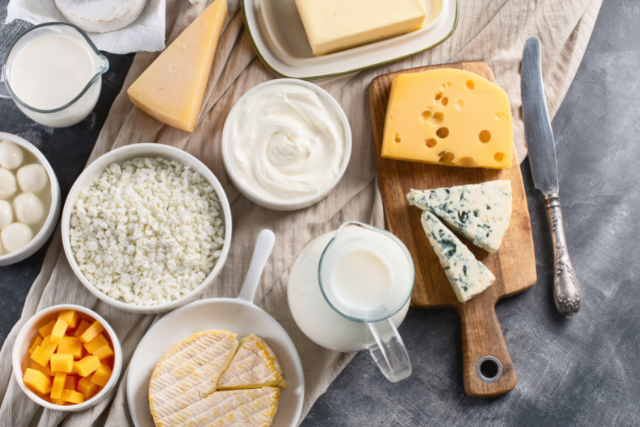WHAT IS LACTOSE?
Lactose is a naturally occurring sugar found in milk and other dairy products (yogurt, cheese and ice cream). When you consume food or drinks containing lactose, an enzyme named lactase in the small bowel will break down lactose into two simple sugars: glucose and galactose. These nutrients are then absorbed in the small intestine.

WHAT IS LACTOSE INTOLERANCE?
However, some people might produce less lactase than the others. If the small bowel has insufficient lactase, the lactose consumed will not be digested properly and will continue through to the large bowel. Lactose in the large bowel will be fermented by the gut bacteria, which produces gases including hydrogen, carbon dioxide and methane. This gas production not only can lead to unpleasant gastro-intestinal symptoms such as distention, bloating, flatulence and constipation but can also draw water into the large bowel resulting in loose stools or diarrhea.
Some people may have a temporary lactose intolerance due to viral infection like the stomach bug, while others can experience it when they have a digestive disorder like celiac disease. Still others may experience lactose intolerance their entire lives.
SYMPTOMS

- bloating
- abdominal pain due to gas
- tummy cramps
- nausea
- loose stool or diarrhea
If you are lactose intolerant, the symptoms may vary and are dose-dependent. That is, the more lactose you consume, the worse the symptoms become. Symptoms may occur immediately after drinking milk or eating dairy products, or they may be delayed for hours.
Lactose intolerance is NOT an allergy to milk.
DIAGNOSIS
To diagnose lactose intolerance, the hydrogen breath test is a simple, non-invasive and reliable investigation test. Lactose intolerance is indicated when hydrogen and methane levels of breath meet a certain criteria following the oral consumption of standard dose of lactose.
Another simple way to diagnose lactose intolerance is an elimination diet which involves removing lactose in the diet and assessing whether symptoms improve, followed by a re-introduction of lactose in the diet to assess whether symptoms return.
WHAT FOODS CONTAIN LACTOSE?

Read the ingredient list on product labels to find out if the product contains a lactose-cotaining food. Food items to look out for include: milk, milk solids, malted milk, buttermilk, curds, cheese flavours, non-fat milk powder, non-fat milk solids, sweet or sour cream, lactose, whey and yogurt.
Note: 1) the cultures in yogurt help to digest lactose 2)Products that contain lactic acid, lactalbumin, lactate and casein do not contain lactose.
IF YOU ARE LACTOSE INTOLERANT, SHOULD ALL DAIRY PRODUCTS BE AVOIDED?
Yes, you will need to modify the diet in order to alleviate the discomfort and symptoms at the beginning. The first step is to remove all sources of lactose in the diet that can cause problematic symptoms, including milk and dairy products.
The second step is to find nutritious substitutions for those items you’re removing:
Note: 1)”Lactose free” means that there is no detectable lactose in the food. 2)”Lactose-reduced” means that at least 25% of the lactose in the product has been removed.
Recent research has suggested that most people with lactose intolerance can consume up to 12 to 15g of lactose without any symptoms. You can still tolerate some foods that contain lactose like yogurt or cheese, even if you are lactose intolerant.
OTHER TIPS ABOUT INCLUDING LACTOSE IN YOU AND YOUR CHILD’S DIET:
- Drink milk in smaller quantities. Most people with lactose intolerance can tolerate 1/2 cup milk at a time.
- Eat small amounts of lactose-containing foods spaced throughout the day.
- Eat with other solid foods may delay digestion, offering more time for the lactase enzyme to break down lactose.
- Yogurt may also be tolerated (plain better than flavoured), because the live bacteria in the yogurt partially digests the lactose before consumption. Yogurt is also a semisolid, which moves slowly through the digestive tract.
- Aged cheese tend to have lower lactose content.
- Try lactase enzyme drops or tablets from the pharmacy. Tablets are taken before eating foods that have lactose. Enzyme drops can be added to milk before drinking.
- Soy products do not contain any lactose and can be a suitable substitute for dairy products, providing they have calcium added.


Leave A Comment